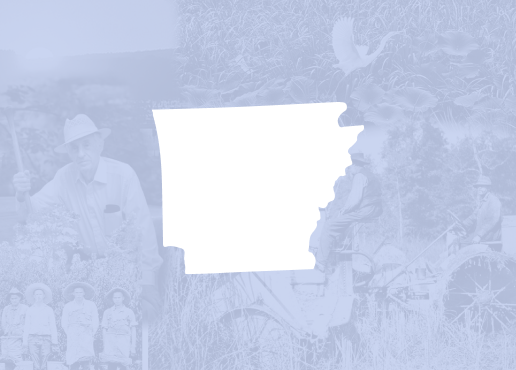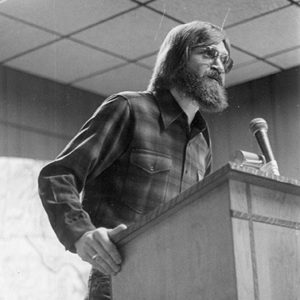calsfoundation@cals.org
Back-to-the-Land Movement
During the late 1960s and early 1970s, nearly one million people throughout the United States left urbanized areas for rural settings, intent on establishing themselves as “back-to-the-landers.” While many of these people moved to the Northeast or the West, which had long been centers of counter-cultural movements, a significant number were drawn to the Ozark Mountains of Arkansas. It is difficult to state how many back-to-the-landers (BTLs) moved to Arkansas between 1968 and 1982, but rough estimates suggest that it was somewhere between 2,000 and 6,000.
Nearly all of the BTLs who moved to the region were in their early to mid-twenties. On the whole, the BTLs were well educated, with over seventy percent having completed an undergraduate degree. Approximately eighty-five percent of the respondents in a survey conducted by Jared M. Phillips at the University of Arkansas in Fayetteville (Washington County) had come from or returned from urban areas such as New Orleans, Louisiana, or Chicago, Illinois, with a few from Fayetteville or Little Rock (Pulaski County) heading to the hills. Nearly all BTLs were white and from middle-class families, and few had practical knowledge of how to live “on the land.”
From World War II until 1960, the state’s population had dropped from nearly 2 million residents to 1.75 million. From 1960 to 1970, there had been slight growth, up to 1.9 million, but beginning with the 1970s, the population skyrocketed in comparison to the previous twenty years. From 1970 to 1980, the state experienced an 18.9 percent growth in population, adding some 363,000 people. In the Northwest and White River planning districts, where the bulk of the Ozark counties are located, the changes were even greater: in the Northwest, there had been a population increase of 40.6 percent over the decade; in the White River region, thirty-two percent.
The BTLs were part of this larger influx of outsiders into the state, an in-migration that was often dealt with warily by locals, as a sudden influx of outsiders of any persuasion tends to lead to high emotions. While perhaps the most visible, the “country hippies” constituted only a small part of the influx. The majority of the state’s new residents—nearly eighty percent—were retirees (approximately sixty percent) and returnees.
Edd Jeffords—a returnee to the state, sometime member of the BTL movement, and founder of the Ozark Institute—argued that better roads, industry relocation, college and school growth, and development of retiree communities all helped bring people to rural areas. These factors worked alongside longstanding urban concerns about crime, pollution, and crowding. People in teeming cities were drawn to wide-open Arkansas—even by 1980, population per mile in Arkansas was 43.9, much lower than the national average of 64 people per mile. These things, plus low land prices, were significant motivators for many in the back-to-the-land community. In the 1970s, for example, one could purchase nearly ninety acres with a year-round spring in the Ozarks for less than $20,000 (though BTL groups did not often purchase such land).
BTLs learned about the charms of the Ozarks, and its low land prices, in a variety of ways. In major publications such as Mother Earth News, articles throughout the 1970s extolled the virtues of Ozark living, providing contact information in the back sections. United Farm Catalogue and other publications had similar classified sections that advertised land for sale or people looking for partners in land trusts or just companionship in the hills. Others learned about the region through friends or from their own travels. In some cases, groups moved to the Ozarks in order to form communes, such as the Lothlorien group outside of Eureka Springs (Carroll County) or women’s intentional communities, such as Yellowhammer in Madison County.
The story of Bob and Hillary Billig can help illustrate the attraction of the Ozarks to a certain segment of people. Bob Billig and his wife, Hillary, moved to the region from New York, where he had been teacher. The Billigs had left for the countryside in a wave of disillusionment in the wake of the discord and tumult of 1960s America, as riots, Cold War fears, and dissatisfaction with protest methods grew. The Billigs sought a connected community without turmoil and found this as they joined the BTL group in Madison County. They arrived in the Ozarks after visiting places throughout the country and quickly became affiliated with the Headwaters School, a free school established by the BTL community in the county to help make up for perceived gaps in the rural education system as well to provide basic community networking. In general, as with the Billigs, a desire to create a just world with meaningful human contact pervaded the Ozark BTL movement.
While there were some conflicts in Eureka Springs and elsewhere between the BTL community and locals, only rarely did these lead to problems, such as house burnings or physical threats. In general, reactions to the BTLs were either benign or helpful. For example, in Newton County, Dan and Marylou Taylor and their two sons moved outside of Parthenon (near Jasper) to a 160-acre farm, where they grew vegetables and raised livestock. Since moving to the land in March 1973, they subsisted on only what they could grow or raise themselves, and they bought only goods such as salt, sugar, yeast, or vinegar. Their lifestyle, reported on by the Arkansas Gazette in April 1977, was similar to what many BTLs in the Ozarks either achieved or aspired to: a combination of new technologies such as solar power and old technologies such as oxen teams in order to live a life “off the grid.” It was a strenuous life, but, for the Taylors, the benefits to their family and the environment were worth the work. When asked how the local community received them, Dan Taylor said that the family had not been enthusiastically accepted but were seen as “a kind of curiosity.” Elsewhere in the region, back-to-the-land groups got to know native Ozarkers and became part of the local community, gaining the trust of the old-timers as conversations about mutual issues, such as raising goats and growing crops, helped forge a new Ozark citizenry.
The back-to-the-land community often worked to better not just the lives of their own group but also the lives of the native Ozarkers. There is perhaps no better illustration of this than Edd Jeffords, who was originally from Arkansas and had returned by 1972. In 1976 in Eureka Springs, he began the Ozark Institute, a nongovernmental organization focused on bettering the lives of Arkansas’s rural and small-farming population via community canneries, job and education programs, and advocacy for small farmers in the face of industrialized agriculture. Other BTLs, such as Bob Billig, started small businesses, joined or started agencies to help with water or transportation issues, worked to revitalize local history, and laid the foundation for the local-food movement in the Ozarks. Another notable 1970s Arkansas BTL was Joel Davidson, a pioneer of solar technology in the United States.
An event that could serve as an emblem of the movement was the Ozark Mountain Folk Fair. Organized by Jeffords, this was a music festival and craft fair held north of Eureka Springs in 1973 on Memorial Day weekend. The festival drew an audience from around the country, with an estimated attendance of up to 30,000, and featured a diverse mix of musical performances as well as craft vendors and artists.
While some of the original BTLs did leave after one winter or bad summer, many—at least half—stayed for at least two years. Indeed, the amount of time spent on the land in some capacity was generally five to ten years. The legacy of the back-to-the-land movement is still felt throughout the region. Those still on the land and those who once were have helped to create lasting change.
A uniting factor across the BTL community was the desire to create a true, lasting revolution, beginning at the individual level and spiraling outward into society at large. As a result, the community has inspired a new generation of BTLs in Arkansas, many of whom have learned from the mistakes of their predecessors and are focused on sustainable strategies for rural development, small-farm economies, and community education programs. Although this new generation of pioneers may be more realistic about the trials of homesteading, they are no less enthusiastic about ideas of social change starting in the community, which they, like the generation of the 1970s, identify as the key for lasting change.
For additional information:
Arkansas Gazette, April 27, 1977, p. 1B.
Blevins, Brooks. Hill Folks: A History of Arkansas Ozarkers and Their Image. Chapel Hill: University of North Carolina Press, 2002.
Brown, Dona. Back to the Land: The Enduring Dream of Self-Sufficiency in Modern America. Madison: University of Wisconsin Press, 2011.
Campbell, Denele, ed. Aquarian Revolution: Back to the Land 32 Personal Stories. N.p., 2013.
Griffith, April. “Ozark Mountain Folk Fair: History in Our Backyard.” The Back-Stay: A Blog from the Shiloh Museum of Ozark History. https://shilohmuseum.org/ozark-mountain-folk-fair/ (accessed September 13, 2021).
Jacob, Jeffrey. New Pioneers: The Back-to-the-Land Movement and the Search for a Sustainable Future. University Park: Pennsylvania State University Press, 1997.
Kersen, Thomas. Where Misfits Fit: Counterculture and Influence in the Ozarks. Jackson: University Press of Mississippi, 2021.
Neidhardt, Sarah. Twenty Acres: A Seventies Childhood in the Woods. Fayetteville: University of Arkansas Press, 2023.
Phillips, Jared M. “Hipbillies and Hillbillies: Back-to-the-Landers in the Arkansas Ozarks during the 1970s.” Arkansas Historical Quarterly 75 (Summer 2016): 89–110.
———. Hipbillies: Deep Revolution in the Arkansas Ozarks. Fayetteville: University of Arkansas Press, 2019.
Rafferty, Milton D. The Ozarks: Land and Life. 2nd ed. Fayetteville: University of Arkansas Press, 2001.
Jared M. Phillips
University of Arkansas, Fayetteville
 Bioregionalism
Bioregionalism Divergent Prosperity and the Arc of Reform, 1968–2022
Divergent Prosperity and the Arc of Reform, 1968–2022 Immigration
Immigration Edd Jeffords
Edd Jeffords 




This is so interesting. My father was one of these people. In the mid-1970s, he left domestic life in urban New Jersey and purchased property in the woods twelve miles outside Mountain View, Arkansas. He and his girlfriend and her son lived on five acres surrounded by pretty much just forests. They lived in a tent for one year while they built their rock and stone house with bay windows and other parts scavenged from old Victorian-era homes being remodeled. I would visit during the summers. At first, there was just a refrigerator and a power pole in the woods. They had two tents, an outside camp kitchen, an outhouse, and many chickens, goats, horses, dogs, and cats. They could live in the house after a year. They had no knowledge of construction or living off the land, but learned everything from books. My dad quit his life working in the factory and became an artist and farmer. His hair and beard were wild and bushy. There were a few other hippie families there, and they had a communal garden and got together for potlucks and such. The local residents were a bit skeptical but always cautiously friendly. My dad stayed there for a few years, off and on, lived in Memphis for a time attending art school, and eventually moved away to travel then settled in rural Arizona. Those times were so memorable, learning how to do things like make campfires, ride a horse, swim in the beautiful creeks, ride in the back of a pickup truck down the dusty dirt roads, and run wild in the forest.